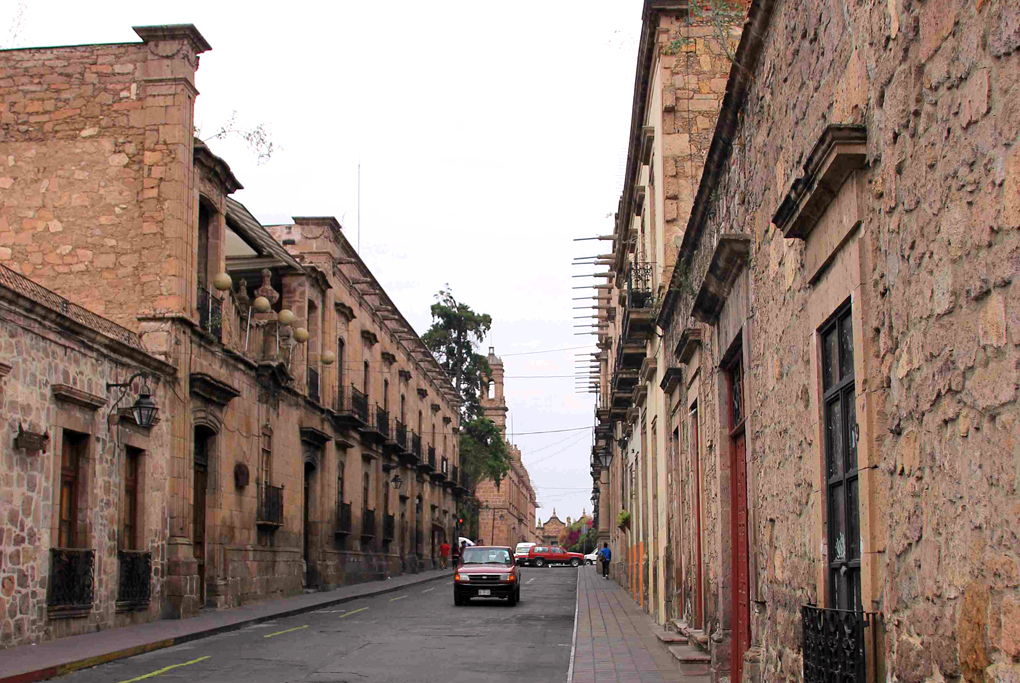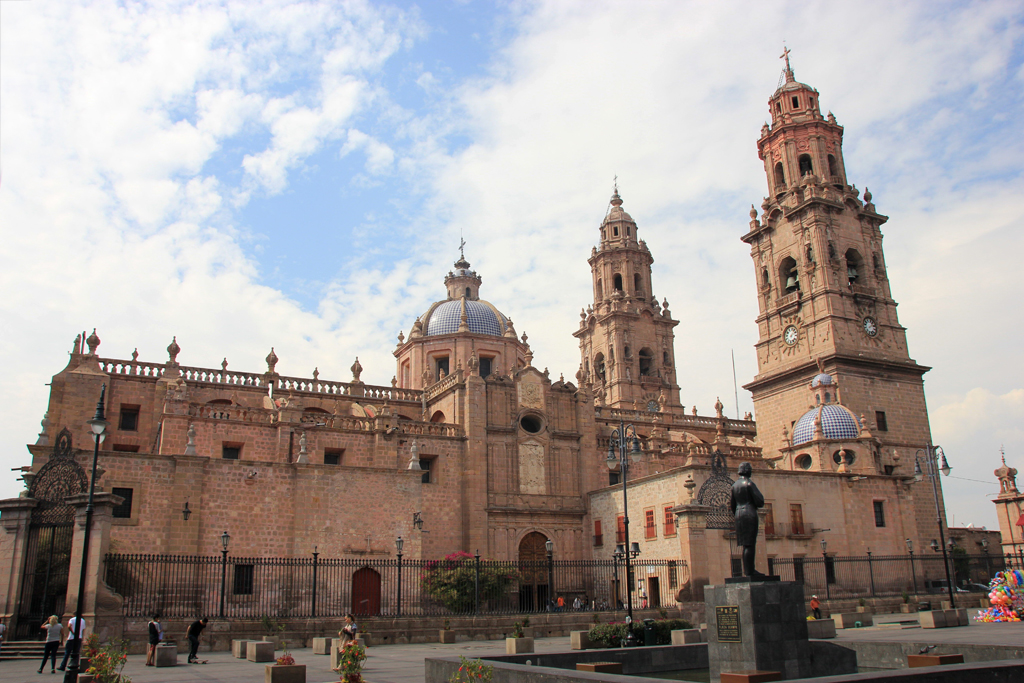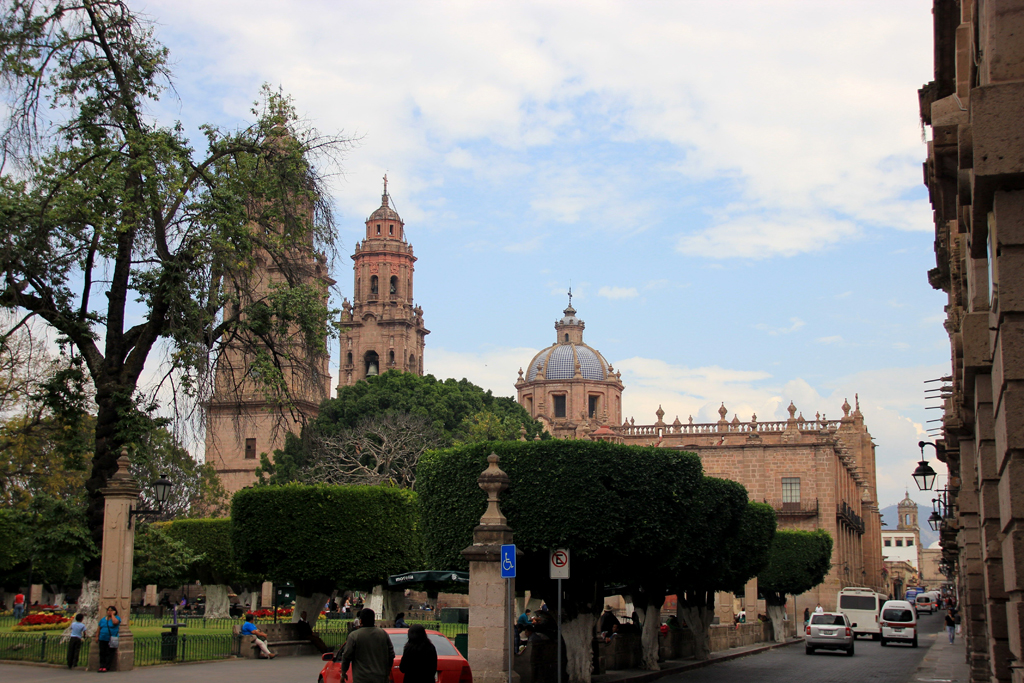
Teotihuacán was our last must-see destination in Mexico; after that a huge part of the country remained for us to explore: the wild and beautiful North that is shaken about by the war on drugs and Baja California. We had toyed with the idea to treat ourselves to a ride on the country’s only existing passenger train route that crosses the Copper Canyon. Before that we wanted to make use of an excellent offer on Airbnb, i.e. an inexpensive accommodation in Morelia that lies about 4 hours by bus west of Teotihuacán.
Morelia is a pretty university town that reminded us in many aspects of Puebla: a colonial heritage, a lot of bookstores, a famous local cuisine and green plazas with huge churches.

We weren’t really keen on visiting another city but we urgently needed a temporary home base to plan our next destinations, update our blog and do some maintenance on our stuff. Eva‘s apartment in Santa Maria, a quiet outlying part of Morelia, offered an ideal furnishing for us and also the ambience to find solace for writing. The only downer was the rather chilly climate: Martin improvised a hot-water bottle for me since it might become around 20 degress „cold“ even during the day.

All in all we spent 10 days in our little house (maisonette with an open kitchen, bedroom and bathroom all to ourselves!) and in the end we had a hard time parting with that cozy environment. We spent a lot of time with cooking (the first available oven since the start of our journey!), writing articles or reading. One time we went for a walk to a huge mall in Altozano since my linen trousers had got a huge tear. I only had one pair of long trousers left so a replacement was urgently needed and my demands were high: it shouldn’t be too expensive and the new trousers had to be of sturdy, breathable and warming material but also not too thick! The problem with mexican stores is that most of the clothes are 100% polyester. Most of it is pretty much cheap rubbish. It might seem strange that I turned to H&M and C&A in search for quality but we were surprised to find these stores in the mall and I preferred to go there. Finally I chose some 30€ outdoor trousers from a sports outfitters: “Performance Fishing Gear” – I won’t use them for that but I couldn’t have found a better replacement for my linen trousers.
Of course we did some trips to historic centre of Morelia – directly in front of our house one of the numerous Colectivo routes went by and for a mere 7 pesos per person (about 40 cents) we could drive some 20 minutes to the city centre. Two of the main attractions there are the cathedral and the aqueduct. It’s also a perfect town for just strolling around; the buildings in the historic centre are all made out of the same type of rock which makes for a uniform appearance.


There’s lots of cafes, restaurants and bookstores and we even discovered a kind of health food shop and a shop with cosplay costumes. A small group of Anonymous protesters, a vegan bistro and bars with indian names give Morelia the feeling of a typical university town.
For the culinary adventurous people there’s also a lot to be found. Very popular are e.g. Gaspachos: a fruit salad with a choice of ground cheese and/or chili-sauce topping.
There was one special event during our stay in Morelia – Martin’s birthday. Our birthday wish lists were very short this year (Martin: to see whales, myself: a truck camper) and the birthday party was a very humble affair. We strolled through town, ate pancakes with vanilla ice cream and Martin used the oven to cook his favourite dish.


Eventually we managed to publish six new articles on our blog during our stay in Morelia. We knew that we wouldn’t have much time for that in the next few weeks. We had changed our mind regarding our travel plans and had decided not to take the El Chepe train through the copper canyon as mentioned above, but rather to take the ferry to La Paz on the Baja California peninsula. The reason for our changed plans were that all the bus rides in Mexico had already cost us a lot of money and that way we hoped to get faster to our goal California to buy a truck camper there. Another very good reason was that February is a perfect month to see whales on Baja California and who wouldn’t want to do that?
German version – deutsche Version
Teotihuacán war unser letzter Fixpunkt in Mexiko, danach stand uns noch der Großteil des Landes offen: Der wilde, schöne aber vom Drogenkrieg gebeutelte Norden und Baja California. Wir liebäugelten mit dem Gedanken die einzige Zugverbindung des Landes zu nutzen, die den Copper Canyon durchquert, nutzten aber vorab noch ein vortreffliches Angebot auf Airbnb, nämlich eine günstige Unterkunft in Morelia, rund 4 Stunden Busfahrt von Teotihuacán entfernt.
Morelia ist eine hübsche Universitätsstadt, die in vielerlei Hinsicht an Puebla erinnert: Koloniales Erbe, viele Buchläden, eine stolze Küche und grüne Plazas mit großen Kirchen.
Ausländische Touristen kommen selten nach Morelia, doch die Mexikaner wissen das große kulturelle Angebot zu schätzen. Die Altstadt ist UNESCO-Weltkulturerbe.
Eigentlich stand uns nicht der Sinn danach, wieder in eine Stadt zu reisen, doch wir brauchten dringend eine Basis, um unsere Weiterreise zu planen, den Blog zu aktualisieren und unsere Ausstattung zu pflegen. Evas Apartment in Santa Maria, einem ruhigeren Außenbezirk von Morelia, bot uns eine ideale Ausstattung und darüber hinaus das Ambiente, um Muße zum Schreiben zu finden. Der einzige Wermutstropfen war das kühle Klima: Martin bastelte mir eine Wärmflasche, weil es selbst tagsüber unter 20 Grad “kalt” wurde.
Wir verbrachten insgesamt 10 Tage in unserem kleinen Haus (Maisonette mit Wohnküche, Schlafzimmer und Bad ganz für uns allein!) und konnten uns nur schwerlich von der heimeligen Umgebung trennen. Wir verbrachten viel Zeit mit Kochen (unser erster Backofen seit Antritt unserer Reise!), Artikel schreiben und Lesen. Einmal liefen wir zu einer großen neuen Mall (Altozano), weil mir meine Leinenhose gerissen war. Ich hatte nun nur noch eine lange Hose, daher musste zügig Ersatz her und die Ansprüche waren hoch: Die Hose sollte nicht nur erschwinglich sondern auch strapazierfähig, atmungsaktiv und wärmend sein und dabei trotzdem dünn! Das Problem bei mexikanischen Klamottenläden ist, dass fast nur 100% Polyester zu bekommen ist. Geradeheraus gesagt: Die meisten Klamotten sind billiger Schrott. Es mag nun befremdlich klingen, dass ich ausgerechnet bei H&M und C&A nach Qualität suchte, aber diese Läden gab es in dieser Mall tatsächlich und ich bevorzugte das. Letztlich fiel die Wahl dann auf eine 30€ Outdoorhose aus dem Sportladen, “Performance Fishing Gear” – dafür werde ich es nicht brauchen aber einen besseren Ersatz für meine Leinenhose hätte ich in der Tat gar nicht finden können.
Natürlich haben wir auch Ausflüge in die Altstadt unternommen – direkt vor unserer Wohnung verlief eine der zahlreichen Colectivo-Linien und für läppische 7 Pesos pro Person (rund 40 Cent) fuhren wir die Zwanzig-Minuten-Strecke bis ins historische Zentrum. Zwei der Haupt-Sehenswürdigkeiten dort sind die Kathedrale und der Aquädukt. Darüber hinaus ist es eine ideale Stadt zum Flanieren; die Häuser in der Altstadt sind allesamt aus demselben Sandstein erbaut, sodass sich ein einheitliches Stadtbild ergibt.
Es gibt zahlreiche Cafés, Restaurants und Buchläden, sogar eine Art Reformhaus und einen Cosplayladen haben wir gesichtet. Ein kleine Gruppe von Anonymous-Demonstranten, ein veganes Bistro und Bars mit indischen Namen geben der Stadt außerdem das Gesicht einer typischen Studentenstadt.
Wer kulinarische Experimente mag, sollte hier auch fündig werden. Sehr beliebt sind zum Beispiel Gaspachos: Fruchtsalate mit wahlweise Käse und/oder Chili-Topping.
Natürlich hatten wir während unserer Morelia-Aufenthaltes auch ein besonderes Event zu begehen: Martins Geburtstag. So bescheiden wie unsere Geburtstagswünsche dieses Jahr ausfielen (Martin: Einen Wal sehen, ich: Truck Camper) war dann auch die Party: Durch die Stadt spazieren, Pfannkuchen mit Vanilleeis essen und Martin bereitete sich seine Lieblingsspeise im Backofen.
Letztlich schafften wir es während unseres Aufenthaltes in Morelia sechs Artikel zu veröffentlichen. Immerhin war auch klar, dass die folgenden Wochen nicht viel Zeit dafür sein würde: Wir hatten unsere Reisepläne kurzerhand überdacht und beschlossen nicht wie anfangs erwähnt den El Chepe Zug durch den Copper Canyon zu nehmen, sondern mit der Fähre nach La Paz auf die Halbinsel Baja California überzusetzen. Der Grund für diesen Planänderung war, dass uns die Busfahrten in Mexiko schon so viel gekostet hatten und wir hofften, auf Baja California schneller zum Ziel zu kommen, nämlich nach Kalifornien, wo wir unseren Truck Camper kaufen wollten. Ein guter Grund war außerdem, dass Februar der perfekte Monat für Walbeobachtungen auf Baja California ist, und wie könnte man sich das entgehen lassen?
